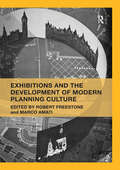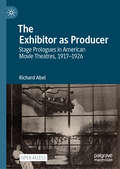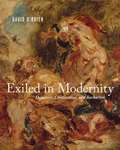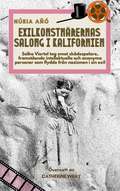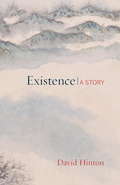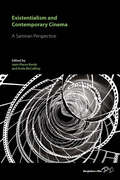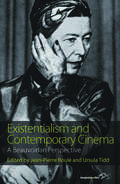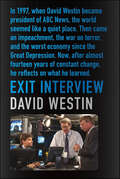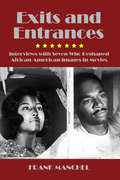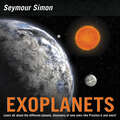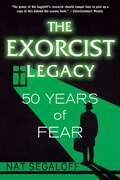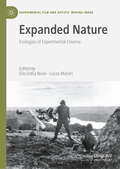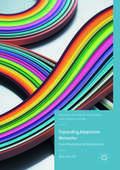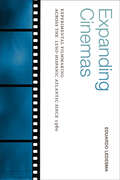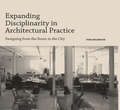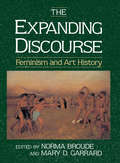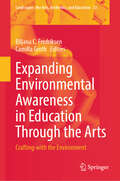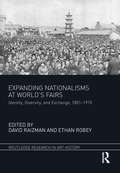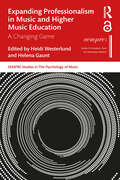- Table View
- List View
Exhibitionist: 1 Journal, 1 Depression, 100 Paintings
by Peter MendelsundFrom acclaimed designer and novelist Peter Mendelsund, a deeply personal reflection on depression and the redemptive power of art, interspersed with 100 original paintingsIn the early days of the pandemic, Peter Mendelsund and his family traveled up to a secluded New Hampshire farmhouse to weather the chaos. There began his journey through a crippling and seemingly intractable depression—which differed in degree but not in kind from episodes that have recurred periodically throughout his life—that brought him to the brink of suicide. Relief came from an unlikely source: painting, something Peter had never contemplated doing before. And yet it became the thing that may very well have saved his life. Bleakly funny, profoundly moving, and—against all odds—truly inspiring, Exhibitionist is not just an account of a mind thinking through its own suffering in real-time, and of the author&’s reckoning with his father's tortured legacy; it's also the story of the birth of an artist, and a portrait of an artist at work.
Exhibitions and the Development of Modern Planning Culture
by Robert Freestone Marco AmatiThe evolution of city planning theory and practice in the first half of the twentieth century was captured and driven by a range of exhibitionary practices in a variety of settings globally, from international expos to local public halls. The agendas of the promoters varied, but exhibitions generally drew their social legitimacy from their status as ’appropriate educative agencies of citizenship’. Bringing together a range of international case studies, this volume explores the highly visual genre of public planning exhibitions worldwide. In doing so, it provides a unique lens on the development of modern urban planning and design from the late 19th century to the present day. Focussing mainly on the first half of the 20th century, it looks in particular at historic exhibitions which sought to transform urban society’s understanding of the possibilities of planning as a force for social betterment. The visuality of presentation, contemporary reactions, and outcomes for the planning profession and the community are explored to make for a unique, innovative and attractive approach to the history of planning ideas. The five major themes are the visual representation of ideas and ideologies; institutions and individuals involved; the broader context of display; and the impacts and implications for the development planning culture. With contributors including Karl Fischer, John Gold, Carola Hein, Peter Larkham, Javier Monclus, and Mark Tewdwr-Jones, the dominant intellectual paradigm further unifying the collection is planning history.
The Exhibitor as Producer: Stage Prologues in American Movie Theatres, 1917-1926
by Richard AbelThis open access book seeks answers to a series of questions about the little studied subject of prologues or theatrical presentations in American movie theaters from the late 1910s to the mid-1920s. How did prologues emerge out of prior practices? Who were the exhibitors most involved? What characteristics would come to define prologues? How widespread did they become not only in metropolitan palace cinemas but also in movie theaters in mid-sized cities and even small towns? If they generally created an atmosphere that complimented or harmonized with the feature films, could they also be what at the time was called “contrastive“? Who were the performers in these theatrical presentations? Were prologues ever described, in ads and audience responses, as a program’s main attraction and to what effect? The book comprises five chapters and up to a hundred photographs of prologue stage settings. Moreover, supplementing each chapter is one or more relevant trade press documents. Overall, the chapters construct a set of practices and typologies that came to define the theatrical presentations that typically preceded the feature films. They also advance this argument: the variety format of combined stage and screen performance in movie theaters has a longer and unexpectedly revealing history than usually assumed. In short, an exhibitor would have a certain degree of creativity in his/her programming, which in turn could strongly impact an audience’s movie-going experience.
Exiled in Modernity: Delacroix, Civilization, and Barbarism
by David O'BrienNotions of civilization and barbarism were intrinsic to Eugène Delacroix’s artistic practice: he wrote regularly about these concepts in his journal, and the tensions between the two were the subject of numerous paintings, including his most ambitious mural project, the ceiling of the Library of the Chamber of Deputies in the Palais Bourbon. Exiled in Modernity delves deeply into these themes, revealing why Delacroix’s disillusionment with modernity increasingly led him to seek spiritual release or epiphany in the sensual qualities of painting. <p><p> While civilization implied a degree of control and the constraint of natural impulses for Delacroix, barbarism evoked something uncontrolled and impulsive. Seeing himself as part of a grand tradition extending back to ancient Greece, Delacroix was profoundly aware of the wealth and power that set nineteenth-century Europe apart from the rest of the world. Yet he was fascinated by civilization’s chaotic underbelly. In analyzing Delacroix’s art and prose, David O’Brien illuminates the artist’s effort to reconcile the erudite, tradition-bound aspects of painting with a desire to reach viewers in a more direct, unrestrained manner. <p> Focusing chiefly on Delacroix’s musings about civilization in his famous journal, his major mural projects on the theme of civilization, and the place of civilization in his paintings of North Africa and of animals, O’Brien links Delacroix’s increasingly pessimistic view of modernity to his desire to use his art to provide access to a more fulfilling experience.With more than one hundred illustrations, this original, astute analysis of Delacroix and his work explains why he became an inspiration for modernist painters over the half-century following his death. Art historians and scholars of modernism especially will find great value in O’Brien’s work.
Exiled in Modernity: Delacroix, Civilization, and Barbarism
by David O'BrienNotions of civilization and barbarism were intrinsic to Eugène Delacroix’s artistic practice: he wrote regularly about these concepts in his journal, and the tensions between the two were the subject of numerous paintings, including his most ambitious mural project, the ceiling of the Library of the Chamber of Deputies in the Palais Bourbon. Exiled in Modernity delves deeply into these themes, revealing why Delacroix’s disillusionment with modernity increasingly led him to seek spiritual release or epiphany in the sensual qualities of painting.While civilization implied a degree of control and the constraint of natural impulses for Delacroix, barbarism evoked something uncontrolled and impulsive. Seeing himself as part of a grand tradition extending back to ancient Greece, Delacroix was profoundly aware of the wealth and power that set nineteenth-century Europe apart from the rest of the world. Yet he was fascinated by civilization’s chaotic underbelly. In analyzing Delacroix’s art and prose, David O’Brien illuminates the artist’s effort to reconcile the erudite, tradition-bound aspects of painting with a desire to reach viewers in a more direct, unrestrained manner. Focusing chiefly on Delacroix’s musings about civilization in his famous journal, his major mural projects on the theme of civilization, and the place of civilization in his paintings of North Africa and of animals, O’Brien links Delacroix’s increasingly pessimistic view of modernity to his desire to use his art to provide access to a more fulfilling experience.With more than one hundred illustrations, this original, astute analysis of Delacroix and his work explains why he became an inspiration for modernist painters over the half-century following his death. Art historians and scholars of modernism especially will find great value in O’Brien’s work.
Exilkonstnärernas salong i Kalifornien: Salka Viertel tog emot skådespelare och intellektuella som flydde från nazismen i sin exil
by Núria Añó"Exilkonstnärernas salong i Kalifornien" är en biografi om Salka Viertel, en judisk skådespelerska som emigrerade till Hollywood och blev populärt känd som manusförfattaren till den svenska skådespelerskan Greta Garbo. Dessutom hade hon en salong i Santa Monica, Kalifornien, där en stor del av den europeiska exilintelligentsian samlades. Salka var en mycket modern och intressant kvinna för sin tid, och hon förtjänar att bli känd som hon verkligen är värd. I boken behandlas ämnen som den påstådda bisexualiteten hos Salka Viertel och de många erkända vänner hon hade, såsom Albert Einstein, Charles Chaplin, Sergei Eisenstein, F. W. Murnau, Max Reinhardt, Arnold Schönberg, Thomas Mann, Bertolt Brecht, Greta Garbo, Montgomery Clift, för att nämna några. Liksom Gertrude Stein och andra framstående kvinnor hade hon dessutom sin egen litterära salong, där författare som Truman Capote, Christopher Isherwood, Gore Vidal och många fler deltog. Andra ämnen som tas upp är Berlin på 1920-talet; övergången från stumfilm till ljudfilm, sett från filmens mecka, Hollywood. Sedan Hitlers uppgång och vad det innebar för den judiska situationen; exilen för de intellektuella som inte kunde återvända till sina respektive länder på grund av andra världskriget. Senare, kalla kriget och häxjakten mot kommunismen. Faktum är att Salka Viertels liv och hennes vänners krets berör de stora händelserna under 1900-talet. För detta projekt erhöll författaren stipendier från Shanghai Writing Program (Kina, 2016) och Baltic Centre (Sverige, 2017). "Trots att Salka Viertel var en så central gestalt i exilsamhället, har det skrivits väldigt lite om henne, vilket gör Núria Añós bok till ett korrektiv, och hon fyller många av luckorna i Främlingarna på Mabery Road." —Dialog International "En mycket intressant berättelse och jag tycker fortfarande att den är mycket aktuell, eftersom vi enligt min mening inte har ko
Existence
by David Hinton"Join David Hinton on an exploration of the entire nature of reality-an ambitious project for such a compact book, and even more amazing when you see that this cosmic journey happens all within the exploration of a single Chinese landscape painting. The painting called Peaceful-Distance Pavilion by Shih-t'ao (1642-1707) is, like other paintings in that genre, mostly space- one tiny figure, accompanied by an attendant, looks out over a vast landscape of mountains and clouds. But start looking into that space and, with the right guidance, what you end up seeing is profound. David Hinton is the perfect guide. He uses his knowledge of Chinese philosophy, poetry, art, language, and writing system to illuminate this painting's message, which is ultimately the story of the glorious dance between nothing and everything, between emptiness and existence. It's an enthralling journey that can change the way you look at the world, a journey for which David is a wise and eloquent guid"
Existentialism And Contemporary Cinema
by Enda Mccaffrey Jean-Pierre BoulaAt the heart of this volume is the assertion that Sartrean existentialism, most prominent in the 1940s, particularly in France, is still relevant as a way of interpreting the world today. Film, by reflecting philosophical concerns in the actions and choices of characters, continues and extends a tradition in which art exemplifies the understanding of existentialist philosophy. In a scholarly yet accessible style, the contributors exploit the rich interplay between Sartre's philosophy, plays and novels, and a number of contemporary films including No Country for Old Men, Lost in Translation and The Truman Show, with film-makers including the Dardenne brothers, Michael Haneke, and Mike Leigh. This volume will be of interest to students who are coming to Sartre's work for the first time and to those who would like to read films within an existentialist perspective.
Existentialism and Contemporary Cinema
by Ursula Tidd Jean-Pierre BouleSimone de Beauvoir's work has not often been associated with film studies, which appears paradoxical when it is recognized that she was the first feminist thinker to inaugurate the concept of the gendered 'othering' gaze. This book is an attempt to redress this balance and reopen the dialogue between Beauvoir's writings and film studies. The authors analyse a range of films, from directors including Claire Denis, Michael Haneke, Lucille Hadzihalilovic, Sam Mendes, and Sally Potter, by drawing from Beauvoir's key works such as The Second Sex (1949), The Ethics of Ambiguity (1947) and Old Age (1970).
Exit Interview
by David WestinWhen David Westin became president of ABC News in March 1997, the division was treading water. "It looked like all the really important news was behind us," he writes. Hardly. For the next thirteen years, Westin would preside over ABC News during some of the most important and perplexing events in its history:• President Clinton's impeachment• The tied 2000 presidential election• The 9/11 attacks• Conflicts in Iraq and Afghanistan• The swift boat smear campaign against Senator John KerryExit Interview is a behind-the-scenes look at Westin's tenure and the major news that marked it. He takes us inside the chaos of the newsroom—alongside major players such as Peter Jennings, Barbara Walters, Diane Sawyer, and Bob Woodruff—where what looks clear and certain from the outside is often mired in conflict and urgency. Neither an apologia nor a critique, the book charts the ups and downs of fourteen formative years in network news, addressing basic questions about how our news is reported, from the point of view of someone who was there. With milestones from the recent past, Westin explores the uncertainty inherent in his job, and its central question: Is it possible for journalists to be both good at their jobs and people of good moral character?
Exits and Entrances: Interviews with Seven Who Reshaped African-American Images in Movies
by Frank Manchel“A worthy successor to Every Step a Struggle . . . the contributions to American cinema of these determined and courageous rebels will never be forgotten.” —Denise Youngblood, author ofCinematic Cold WarWhile Every Step a Struggle recalled the performers who fought to give black artists a voice and a presence in film and on stage, this new ground-breaking book focuses on the personalities who replaced the pioneers and refused to abide by Jim Crow traditions. Presented against a detailed background of the revolutionary post-World War II era up to the mid-1970s, the individual views of Mae Mercer, Brock Peters, Jim Brown, Ivan Dixon, James Whitmore, William Marshall and Ruby Dee in heretofore unpublished conversations from the past reveal just how tumultuous and extraordinary the technological, political, and social changes were for the artists and the film industry. Using extensive documentation, hundreds of films, and fascinating private recollections, Dr. Manchel puts a human face both on popular culture and race relations.“Using the method of oral history and the mature thinking of a senior scholar, Exits and Entrances enhances our understanding of the difficult slog to create a truthful, ‘round’ image of African-Americans in U.S. commercial films. This collection is a gold mine of information for future research and should be in all libraries which value film research.” —Peter C. Rollins, Emeritus Editor-in-Chief of Film & History
Exoplanets
by Seymour SimonAward-winning science writer Seymour Simon explores the farthest reaches of space in the brand-new Exoplanets! This nonfiction picture book is an excellent choice to share during homeschooling, in particular for children ages 6 to 8. It’s a fun way to learn to read and as a supplement for activity books for children.There are thousands of exoplanets scattered throughout the Milky Way galaxy, and scientists are on a constant quest to find one just like Earth. In Exoplanets, Simon examines the planets outside of our solar system and uncovers what makes them habitable, our efforts to discover new life, and more.With clear, simple text and stunning full-color photographs, readers will explore the farthest reaches of space and explore the answer to the question: do aliens exist?This book includes an author's note, a glossary, an index, and supports the Common Core State Standards.
The Exorcist Legacy: 50 Years of Fear
by Nat SegaloffThe definitive, fascinating story of the scariest film ever made and its enduring impact in Hollywood and beyond—from the director&’s biographer comes a must-read for horror fans and cinema buffs, just in time for the movie&’s 50th anniversary and the release of the first movie in a new Exorcist trilogy. Includes a foreword by John Russo, author and cowriter of the seminal horror film Night of the Living Dead. On December 26, 1973, The Exorcist was released. Within days it had become legend. Moviegoers braved hours-long lines in winter weather to see it. Some audience members famously fainted or vomited. Half a century later, the movie that both inspired and transcends the modern horror genre has lost none of its power to terrify and unsettle. The Exorcist Legacy reveals the complete story of this cultural phenomenon, from the real-life exorcism in 1949 Maryland that inspired William Peter Blatty&’s bestselling novel on which the movie is based, to its many sequels, prequels, TV series, and homages. Nat Segaloff, biographer of the film&’s director, William Friedkin, draws on original interviews with cast, crew, and participants as well as revelations from personal papers to present an intriguing and surprising new view of the making of the movie, and its aftermath. Segaloff also examines as never before the keys to the movie&’s enduring appeal. Friedkin and Blatty&’s goal was far more ambitious than making a scary movie; they aimed to make people &“think about the concept of good and evil.&” The Exorcist succeeds, and then some, not just by creating on-screen scares, but by challenging viewers&’ deepest personal beliefs—and fears.
Exotic Adornments: 18 Luxurious Beadwork Jewelry Projects
by Kelly WieseGlitz, glamour--and beads! Jewel tones, crystals, and metallic meet in Exotic Adornments. Appropriate for the office but as fun as a night out, the cuffs, chokers, necklaces, rings, and earrings in this easy-to-use guide are sure to catch attention--and envy! Led by Beadwork Magazine's Beadwork Designer of the Year Kelly Wiese, you'll create opulent, extravagant statement pieces that take any outfit from flat to fab. For some fun, elegance, and sparkle, go big with the Soiree Ring, perfect for date night. Add a touch of drama to your look with the All That Glitters Lariat, customizing the length to suit your style. Looking for a piece that works in a professional setting? The Madison Avenue Bracelet pairs pearls with crystals for a classic, classy look. No matter which of the 18 pieces you start with, you'll want to give your entire jewelry collection a luxurious makeover with Exotic Adornments!
Exotic Flowers for Artists and Craftspeople (Dover Pictorial Archive)
by Yuko GreenThe lavish colors and exotic beauty of tropical flowers have long made them favorite subjects of artists and craftspeople. This splendid sourcebook of copyright-free illustrations offers workers in many arts and crafts a marvelous sampling of lovely blossoms from rain forests, jungles, and tropical regions around the world. Depicting blossoms from trees, shrubs, vines, and ornamental herbs, 135 accurately detailed drawings depict a host of superb specimens, as varied in size and shape as they are in natural habitat. Included are the Indian Coral Tree, Sausage Tree, Monkeypod, Shrimp Plant, Crown Flower, Blushing Bride, Cup of Gold, Bird of Paradise, African Tulip, Angel's Trumpet, Butterfly Hibiscus, Thimbleberry, King Protea, Crown of Thorns, Passion Flower, Rattle Shaker, Orchid Tree, Rose Apple, Gardenia, Candle Bush, Pincushion, Lipstick Plant, Orange Trumpet, Spider Lily, and over 100 other flowers.All are identified by their common and scientific names as well as by regions of origin. Ideal for adding dramatic accents to embroidery projects and textile patterns, for use in woodworking, leathercraft, metalwork, and a host of other crafts, this varied collection represents a superb resource for artists, illustrators, and anyone in need of striking floral decorations.
Expanded Nature: Écologies du cinéma expérimental (Experimental Film and Artists’ Moving Image)
by Elio Della Noce Lucas MurariThis book explores the emergence of ecological consciousness in the work of contemporary experimental filmmakers. If it can be said that experimental filmmakers are "expanding" the artistic field through an exploration of the potencies, modes of dissemination and performance of the moving image, in the Anthropocene these practices strive for another kind of expansion: to expand our experience of nature. Appending flowers to the film strip or burying it in the ground, inventing observational devices, allowing the camera to be affected by natural forces, engaging one's own filming body in a symbiotic relationship with the environment, reconstituting ecosystems at the moment of projection: the ecologies of experimental cinema presented in this book constitute forms of practice and engagement that awaken a heightened sensibility towards the living world through cooperative links, casting other beings as subjects and agents of filmic processes, and, finally, reshaping the economy of filmmaking. Thus, ecologies of perception, medium, production, and multinaturalism are deployed, contributing to the restoration of our sensory bond with the natural world. Several chapters were translated with the help of artificial intelligence. In each case, the text has subsequently been revised further by the author as well as the translator Charlie Hewison and a professional copy editor.
Expanding Adaptation Networks: From Illustration to Novelization (Palgrave Studies in Adaptation and Visual Culture)
by Kate NewellThis book addresses print-based modes of adaptation that have not conventionally been theorized as adaptations—such as novelization, illustration, literary maps, pop-up books, and ekphrasis. It discusses a broad range of image and word-based adaptations of popular literary works, among them The Wizard of Oz, Alice in Wonderland, Daisy Miller, The Strange Case of Dr. Jekyll and Mr. Hyde, Moby Dick, and Adventures of Huckleberry Finn. The study reveals that commercial and franchise works and ephemera play a key role in establishing a work’s iconography. Newell argues that the cultural knowledge and memory of a work is constructed through reiterative processes and proposes a network-based model of adaptation to explain this. Whereas most adaptation studies prioritize film and television, this book’s focus on print invites new entry points for the study of adaptation.
Expanding Austenland: The Pride and Prejudice Fanfiction Archive (Palgrave Fan Studies)
by Áine MaddenExpanding Austenland: The Pride and Prejudice Fanfiction Archive explores Jane Austen’s reception in popular culture through an exploration of the ever-expanding terrain of online fanfiction, professionally published (profic) texts, and other intertextual reworkings inspired by the author’s most popular novel, Pride and Prejudice. The book argues that given its pervasiveness, Pride and Prejudice could be usefully considered not as a single novel, but as an entire ‘archive’ of interrelated texts, or as a portal that opens a ‘virtual world’ for readers to expand and explore. By examining the Pride and Prejudice archive of interrelated texts, this book analyses the process through which an individual novel can develop a virtual life, or afterlife. The evolving world that is opened by Pride and Prejudice, and extended and enriched through fanfiction, is conceptualised in the monograph as ‘Austenland’.
Expanding Cinemas: Experimental Filmmaking across the Luso-Hispanic Atlantic since 1960 (SUNY series in Latin American Cinema)
by Eduardo LedesmaThis is the first book on experimental cinemas of Latin American and Spain to offer a comprehensive look at old and new technologies, including Super 8, VHS, cell phones, virtual reality, artificial intelligence, and more. From the militant films of the 1960s to today's expanded reality experiences, filmmakers in Argentina, Spain, Cuba, Colombia, Brazil, and Mexico have continually used alternative formats both to dialogue with international movements and to counter commercial cinematic trends. To make this argument and cover this vast geographic and historical terrain, Eduardo Ledesma adopts a transnational and intermedial approach, examining exchanges and associations between cineastes to better understand how their films were created and circulated. Ledesma works to untangle both the relations between media and the associations of experimental cinema to cultural phenomena such as diaspora, exile, displacement, and immigration. Throughout the book, connections are further made to other global avant-garde and alternative cinemas and formats, including in the United States.
Expanding Disciplinarity in Architectural Practice: Designing from the Room to the City (Design Research in Architecture)
by Tom HolbrookExpanding Disciplinarity in Architectural Practice presents an argument for the role of an architect as a generalist with a particular ability to bring spatial intelligence to bear on the significant issues of planning, settlement, and identity. The book draws on strategy and planning, landscape, infrastructure, urbanism, historical conservation, and interpretation, architecture, and the creative reuse of existing structures to encourage you to incorporate a holistic approach to your designs. Tracing a series of projects developed by his practice 5th Studio, author Tom Holbrook argues the critical importance of involving spatial practitioners in large scale strategies and designs to combine interdisciplinary thinking and concrete experience of buildings. The book incorporates interviews with prominent figures in the field of architecture, eleven UK case studies, and over 200 beautiful illustrations including the author’s own award-winning designs. With twenty years of evolving practical experience, together with associated research, teaching, and writing, Holbrook shows you how a participatory infrastructure creates a crucial bridge between strategic thinking and the reality of the built environment. This book is a must-read for professionals seeking to incorporate broader design strategy into their practice.
The Expanding Discourse: Feminism And Art History
by Norma BroudeA sequel to the pioneering volume, Feminism and Art History: Questioning the Litany, published in 1982, The Expanding Discourse contains 29 essays on artists and issues from the Renaissance to the present, representing some of the best feminist art-historical writing of the past decade. Chronologically arranged, the essays demonstrate the abundance, diversity, and main conceptual trends in recent feminist scholarship.
Expanding Environmental Awareness in Education Through the Arts: Crafting-with the Environment (Landscapes: the Arts, Aesthetics, and Education #33)
by Biljana C. Fredriksen Camilla GrothChapters “Crafting in Dialogue with the Material Environment” and “Soil Laboratory: Crafting Experiments in an Exhibition Setting” are available open access under a Creative Commons Attribution 4.0 International License via [link.springer.com|http://link.springer.com/].thors’ own experiences with phenomena they are trying to understand and critically explore. This book is of interest to professional creative practitioners, art and craft educators, art teacher educators or researchers in the field of creative practices. It has power to inspire rethinking of present educational practices, to ignite critical reflections about materials and more-than-humans, and, hopefully, motivate transformations toward more ecologically sustainable ways of life.
Expanding Nationalisms at World's Fairs: Identity, Diversity, and Exchange, 1851-1915 (Routledge Research in Art History)
by David Raizman Ethan RobeyExpanding Nationalisms at World’s Fairs: Identity, Diversity, and Exchange, 1851–1915 introduces the subject of international exhibitions to art and design historians and a wider audience as a resource for understanding the broad and varied political meanings of design during a period of rapid industrialization, developing nationalism, imperialism, expanding trade and the emergence of a consumer society. Its chapters, written by both established and emerging scholars, are global in scope, and demonstrate specific networks of communication and exchange among designers, manufacturers, markets and nations on the modern world stage from the second half of the nineteenth century into the beginning of the twentieth. Within the overarching theme of nationalism and internationalism as revealed at world’s fairs, the book’s essays will engage a more complex understanding of ideas of competition and community in an age of emergent industrial capitalism, and will investigate the nuances, contradictions and marginalized voices that lie beneath the surface of unity, progress, and global expansion.
Expanding Professionalism in Music and Higher Music Education: A Changing Game (SEMPRE Studies in The Psychology of Music)
by Heidi Westerlund and Helena GauntThis book addresses the need to rethink the concept and enactment of professionalism in music, and how such concepts underpin professional higher music education. There is an urgent imperative to enable the potential of professional musicians in our contemporary societies to be more fully realised, recognising both intense challenges that are currently threatening some traditional music practices, and significant scope for new practices to be imagined in response to deep veins of societal need. Professionalism encompasses the conduct, aims, values, responsibilities and ongoing development of a practising professional in the field. Professional higher music education engages both with providing future professionals with relevant education in particular craft skills, and with nurturing their visions for their work as artists in future societies. The major focus of the book is on performance traditions that have dominated professional higher education, notably western classical music.
Expanding Professionalism in Music and Higher Music Education: A Changing Game (ISSN)
by Heidi Westerlund Helena GauntThis book addresses the need to rethink the concept and enactment of professionalism in music, and how such concepts underpin professional higher music education. There is an urgent imperative to enable the potential of professional musicians in our contemporary societies to be more fully realised, recognising both intense challenges that are currently threatening some traditional music practices, and significant scope for new practices to be imagined in response to deep veins of societal need. Professionalism encompasses the conduct, aims, values, responsibilities and ongoing development of a practising professional in the field. Professional higher music education engages both with providing future professionals with relevant education in particular craft skills, and with nurturing their visions for their work as artists in future societies. The major focus of the book is on performance traditions that have dominated professional higher education, notably western classical music.

